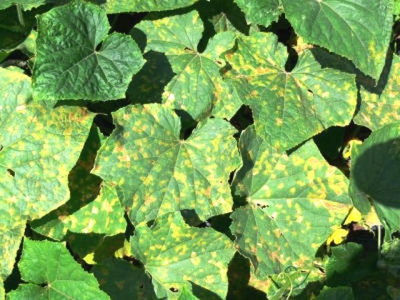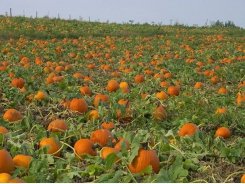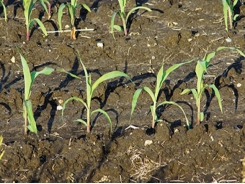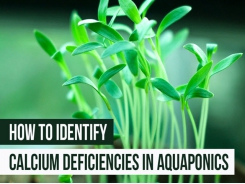Watching your cucurbits grow

As with any crop, there’s a risk to planting cucurbits and then doing ‘bakkie’ farming – skirting the land with your head half-way out of the driver’s side window.
Typical boron deficiency symptoms on a pumpkin leaf.
You need to walk through the land frequently and check that all is in order. For instance, cutworms are always a threat and often not seen until you step onto the land. Fortunately, there are effective remedies for these pests today. In fact, you should never take a chance – telling yourself that things will be all right – as prevention is cheap and easy.
The best remedy, in my opinion, is to apply a pyrethroid with the weedkiller. It’s often assumed that when a land has just come through winter with no weeds there will be no cutworms. This is incorrect. They can survive on crop debris for ages. These are usually large caterpillars by spring. When we plant our cucurbits, they find this lush green growth delicious and can do plenty of damage in a few days.
Healthy, growing Leaves
While walking through the land, look at the condition of the leaves. These should become increasingly larger up to the maximum size for the species or variety planted. The colour should be a healthy green. Sometimes you’ll find holes between the veins on young leaves. If just about every plant has this symptom, this reveals a boron deficiency. A similar symptom develops when small bollworms attack the very young leaves. In this case, however, the holes are usually found on just a few plants.
Another sign of boron deficiency is yellowish, thin tissue in the region of the ‘tears’. It is these areas which develop into holes. Caterpillar damage will not cause this. The problem is easily solved by preventative sprays of Solubor at 1kg/ ha on a few occasions. Boron is a sporadic problem and closely linked to climatic and soil conditions. The symptoms may therefore appear and then disappear.
Bollworms and bees
Bollworms usually don’t do too much damage to the foliage as it grows so fast. They become a problem, however, when the plants start to flower. Caterpillars are especially fond of flowers. As these first flowers are so important (especially on pumpkins), you should particularly guard against bollworms at flowering stage – they may have a significant influence on yield.
When the crop starts to flower, you need to ensure that there are sufficient pollinators present. Honeybees are the main ones, but there are also many other small, solitary bees that are also useful. In areas where there are wild trees, plants and scrubs, these may play a more important role. Bees will start pollinating at first light and, as there’s so much pollen on a single cucurbit anther, the bees become so covered in pollen they appear completely yellow.
To ensure there are enough pollinators around, visit the land a couple of hours after sunrise and check if there’s still pollen on the anthers. They’ll be wiped clean of pollen if there are sufficient number of bees in the area. Some people recommend two hives per hectare, but I find this excessive. A good hive will contain approximately 30 000 honeybees and there are far fewer plants growing on a hectare. In addition, one bee visits several flowers on a trip and makes a number of trips over the pollination period.
Incidentally, it’s only the nectar-collecting bees that pollinate, as they visit both male and female flowers. Bees either collect pollen or nectar; they don’t do both on a trip. There’s a theory that if the stand is too dense, the foliage prevents the bees from finding the flowers. This is not so. Yield losses from such a stand occur because the flowers are aborted, a subject already covered in this series.
Có thể bạn quan tâm
Phần mềm

Phối trộn thức ăn chăn nuôi

Pha dung dịch thủy canh

Định mức cho tôm ăn

Phối trộn phân bón NPK

Xác định tỷ lệ tôm sống

Chuyển đổi đơn vị phân bón

Xác định công suất sục khí

Chuyển đổi đơn vị tôm

Tính diện tích nhà kính

Tính thể tích ao hồ



 How to Effectively Balance Magnesium in Aquaponics
How to Effectively Balance Magnesium in Aquaponics  How to Identify a Calcium Deficiency in Aquaponics
How to Identify a Calcium Deficiency in Aquaponics